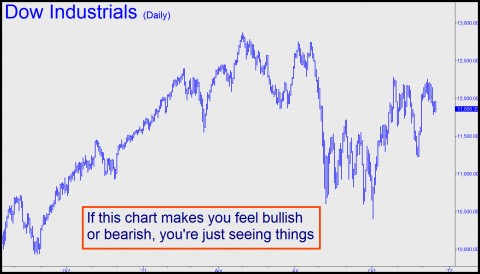Does the chart below of the Dow Industrial Average make you feel bullish? Bearish? Neutral? We’re not sure ourselves. Although we’ve been using technical analysis for nearly 40 years, the chart doesn’t speak to us. At best, it leaves us with only a moderately bullish bias for the near term — and a vague feeling that the meaningless price swings that have ruled the markets in 2011 could continue for longer than we would care to imagine, let alone explain This is hard to believe, especially with so many dreadnoughts bearing down on the global economy and banking system. The U.S. is re-entering a recession that never ended for most households. China has hit the brakes in preparation for a slowdown in global trade, and the country’s real estate bubble appears to be deflating with a vengeance. Jihadists are planning naval “maneuvers” in the Strait of Hormuz. Bird flu and the bubbling Yellowstone caldera threaten us with extinction.
And there is of course Europe, faced with the impossible choice of either monetizing the debts of countries that will never be able to pay them, or letting those countries go bankrupt. We think it is the latter option that will forced on decision-makers, since rich-uncle Germany understands that throwing another two or three trillion euros of debt-money at the problem will not fix it. In any event, the decision cannot be delayed for much longer, since interest rates for sovereign borrowers are becoming increasingly uppity. For Italy, most crucially, rates are edging back toward 7% — the extreme end of the red zone politically and economically – within days of each new phony bailout scheme hatched in Belgium. A disaster is coming, and it is only a question of when.
Like a Kite in a Gale
And yet, U.S. stocks continue to hover, to dive, and to soar like a kite in a gale. Through it all, the Dow is currently trading within 20% of all-time highs. We hesitate to credit the broad averages with “hanging tough,” since it is not hard investment decisions that have sustained the markets, but rather a sea of funny money. Whirlpools, eddies and rogue crests of it drive stocks hither and thither, all presumably to no good end. It mocks the idea of capital – of capitalism itself. No longer does the Econ 101 equation Saving=Investment hold. How can we speak of savings when they are offset by a quadrillion-dollar global edifice of debt that verges on collapse? More to the point, why would anyone invest in productive assets such as manufacturing when financial assets are so much more rewarding? They are very nearly riskless, too, since limitless amounts of cash for financial speculation are available for next to nothing, and even when you “lose,” if you lose big enough, the central bank will make you whole again.
Straddling the Markets
Under the circumstances, which are diabolically unpredictable, Rick’s Picks has been playing both side of the market, locking in spread positions at little or no cost that will make money regardless of what stocks do in the next couple of months. Legging into bearish put spreads in the QQQ, we recently created a position that can lose no more than $20 theoretical but which could make us as much as $1200 if stocks fall between now and late January. That’s effectively getting 60-to-1 odds against a decline in the market. Soon after we locked in this spread, we began to construct its opposite — a bullish play in SPY. Our goal ultimately is to have a mix of bull and bears spreads that have cost us little or nothing and which leave us genuinely unconcerned about which way stocks move over the next five weeks. We also have a bullish trade on in the March E-Mini S&P that has produced a paper gain so far of $2700. The trade was initiated at last week’s exact low, 1198.00. If you are curious about how we determined to get long at that number, click here for a free trial subscription to Rick’s Picks. And if you want to learn how to do it yourself, click here.
***
(If you’d like to have these commentaries delivered free each day to your e-mail box, click here.)


Related links on Keiser (I typed the website wrong):
Why Max Keiser and Jason Hamlin Are Wrong – Part II
http://www.dollarvigilante.com/blog/2011/11/18/why-max-keiser-and-jason-hamlin-are-wrong-part-ii.html
Why Max Keiser and Jason Hamlin are Wrong – Regulating Capitalism is Superfluous and Counterproductive
http://www.dollarvigilante.com/blog/2011/11/17/why-max-keiser-and-jason-hamlin-are-wrong-regulating-capital.html
Does The Economy Need a Referee?
http://www.dollarvigilante.com/blog/2011/10/19/does-the-economy-need-a-referee.html